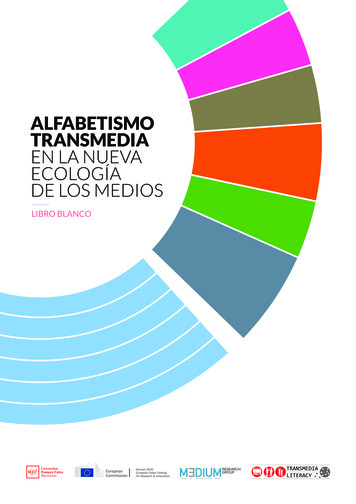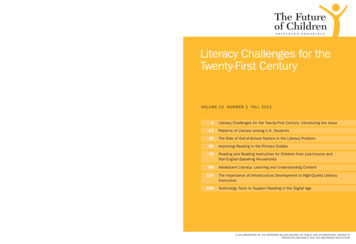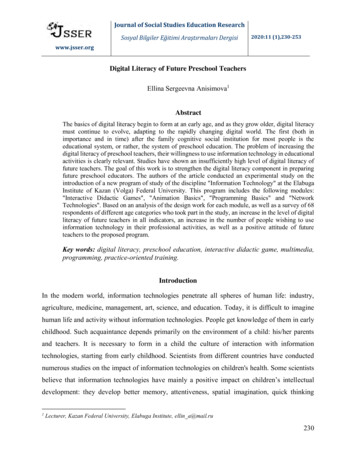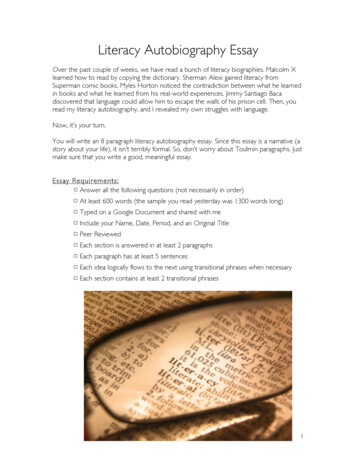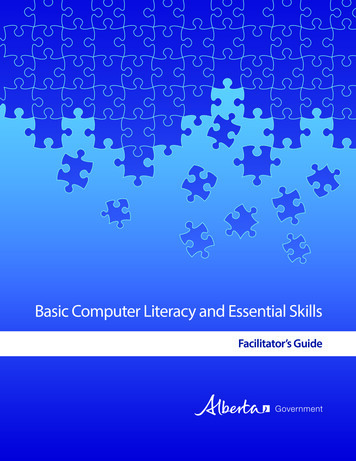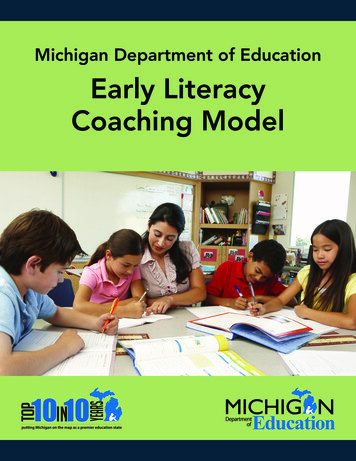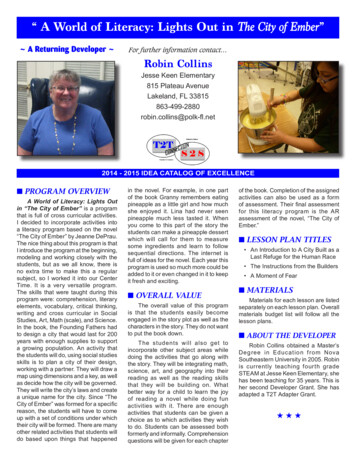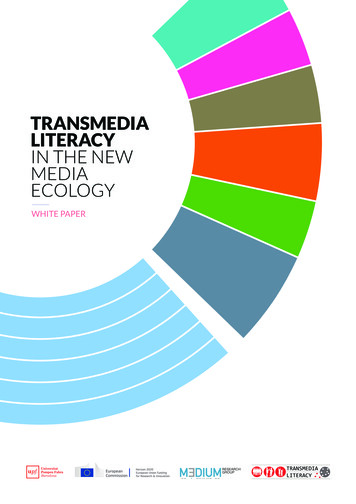
Transcription
WHITE PAPERTRANS MEDIA LITERACYIN THE NEWMEDIAECOLOGYWHITE PAPER1
2TRANSMEDIA LITERACY IN THE NEW MEDIA ECOLOGYWhere are we now?Since the spread of personal computing in the 1980s, theexpansion of the World Wide Web in the 1990s and theemergence of social media and mobile devices in the 2000s,digital technology has been a catalyst for social change incontemporary societies. Although schools have made greatefforts to adapt to the new socio-technical conditions in thepast two decades, the general perception is that the social lifeof children, pre-teens and teens revolves around a set of digitaltechnologies and new practices that are often very differentfrom the educational protocols of schools.INTERVIEWJenny16 YEARS OLD - FEMALESpainResearcher: Have you learnt stuff with videogames apart from whatyou’ve learnt at school?Jenny: Well, there’s this game, “Brain Training” for maths and rapid calculus Researcher: Would you use videogames to teach people?Jenny: I would. I mean, as long as it’s interactive, like, interesting I think that’d be cool.Research into the relationships between teens and the mediahas also been challenged by the mutations of the media ecology.New questions, new research objectives and new methodologieshave been proposed to deal with this new situation.
WHITE PAPERFrom Media Literacyto Transmedia LiteracyThe traditional media literacy approaches developed sincethe 1960s were based on the idea that the media, especiallytelevision, have negative effects on children, and therefore itis necessary to ‘immunize’ young people in schools so they canresist the negative influence of screens.As the media ecosystem evolved, so did media literacy, whichsoon included education and risk prevention in relation to usingthe web, videogames, social networks and mobile devices. Inrecent years, dozens of concepts have been developed to givea name to these new forms of literacy, from ‘digital literacy’ to‘internet literacy’ or ‘new media literacy’.INTERVIEWJorge12 YEARS OLD - MALEPortugalResearcher: Have you read any other books related to videogames?Jorge: I’m reading a fan fiction about a movie, which is about the Joker,and I’m also reading a fan fiction about Harry Potter and “Until Dawn”.Researcher: [ ] What led you to read “Until Dawn”?Jorge: The game.Researcher: Is it the same?Jorge: The fan fiction is quite changed, that’s why it’s different.Researcher: Do they give them different endings?Jorge: Yes, but even in “Until Dawn” there are different endings for lots ofcharacters because the choices people make are what lead to the endings.But here [in fan fiction], it goes another way, with other characters and stories.3
4TRANSMEDIA LITERACY IN THE NEW MEDIA ECOLOGYLITERACYMEDIA LITERACYTRANSMEDIA LITERACYMedia semiotics(language)Verbal text(read/write)MultimodalMultimodalMedia supportsBooks and printed textsPrinted, audiovisualand digitalDigital networks Interactive media TransmediaAim of the actionTo develop critical readersand writersTo develop criticalconsumers and producersTo develop criticalprosumersSubject interpellationAs an illiterateAs a passive mediaconsumerAs a prosumerDirection of the actionTop-down1) Top-down2) Bottom-up1) Bottom-up2) Top-downLearning environmentFormal (schools)Formal (schools),no formal and informalFrom informal to formal(schools)Role of the teacherKnowledge authority –Mediator student/textKnowledge mediator Creator of learningexperiences with the mediaKnowledge facilitator –Cultural translatorTheoretical referencesLinguisticsMedia Studies(Theory of Media Effects) Cultural StudiesMedia Studies(Media Ecology,TransmediaStorytelling studies) Cultural studiesKEY CONCEPTTransmedia LiteracyTransmedia Literacy is understoodas a set of skills, practices, values,sensitivities and learning and exchangestrategies developed and applied inthe context of the new collaborativecultures.Transmedia Literacy starts from a different reading of themedia reality of teens. Without rejecting the postulates of medialiteracy, it expands and complements them with other researchquestions and intervention proposals. Transmedia Literacyfocuses on what young people are doing with the media,considering them prosumers (producers consumers) able togenerate and share media content of different types and levelsof complexity.
WHITE PAPER5Transmedia Literacy does not deny the need to educate youngpeople to develop media skills, but rather it expands thisframework to include research into the media activities thatyoung people do outside educational institutions and proposesbringing this knowledge into the classroom.Transmedia Literacy research projectIn this context the main questions that the Transmedia Literacyresearch project asked were: What are teens doing with media?How do they learn to do things with media? To answer these twoquestions, a methodological strategy was designed that involvedmore than 50 researchers from 10 institutions in 8 countries.Participating countriesSpain (coord.), Australia, Colombia, Finland, Italy, Portugal, United Kingdom and UruguayThe research started on 1 April, 2015, and finished on 31 March,2018. In 36 months the research team carried out a lot of activities:- Designing the research strategy and testing it in Barcelona (2015)- Carrying out the fieldwork in 8 countries (2016)- Analysing the data (2017)- Integrating the data analysis and dissemination of outputs(2017-2018).
6TRANSMEDIA LITERACY IN THE NEW MEDIA ECOLOGYMethodologysurveys, participatory workshops and in-depth interviews.SURVEYWORKSHOPSINTERVIEWSwhole group12-16 students / 120’ x 2individual - max. 90’ / 120’videogame workshop12-14years oldparticipatory culture workshopSCHOOL 115-18years old12-14years oldSCHOOL 215-18years oldThe fieldwork followed a sequence of five complementary phases:1. Schools were considered the best interface between theresearch team and the teens. They were the starting point forfieldwork and a secure way to obtain the informed consents ofinstitutions, parents and teens, as well as make a first contactwith teens.2. An initial questionnaire was filled in by the participatingadolescents to get to know their socio-cultural backgrounds andmedia uses and perceptions;3. Participatory workshops were held to explore in animmersive way the teens’ transmedia storytelling practices andengage them in media production and gameplay;4. In-depth interviews were made with the most active teensand they were asked to fill out media diaries to get to know theirdoings and sayings with media, social networks and videogames;5. The last phase of the data-gathering process was an onlineobservation of the teens’ favourite websites, celebrities, andonline communities (netgraphy).
WHITE PAPERParticipants were aged from 12 to 18 years old and differentschool profiles were selected in each country (private/public,urban/suburban, high-tech/low-tech schools, etc.).During the data-gathering process 1,633 questionnaires, 58participatory culture and videogame workshops, and 311interviews were completed.RESEARCHERSonia Livingstone (UK)‘Research must now identify, intextual terms, how the Internetmediates the representationof knowledge, the framing ofentertainment, and the conduct ofcommunication. And, in tandem withthis analysis, it must investigate theemerging skills and practices of newmedia users as they meaningfullyappropriate ICT into their daily lives.’Source: Livingstone, S. (2004).Media Literacy and the Challengeof New Information andCommunication Technologies. TheCommunication Review, 7:1, 3-14.What are teens doing with media?Teens are doing many things with media, from playingvideogames with friends to writing fan fiction, sharing pictureson Instagram, watching – and sometimes uploading – videos onYouTube and participating in ‘real world’ events dedicated totheir favourite characters and stories. The research team of theTransmedia Literacy project has defined these competences as‘transmedia skills’.7
8TRANSMEDIA LITERACY IN THE NEW MEDIA ECOLOGYObviously, not all young people have these skills or have themto equal degrees: while a teen may have many production orsocial management skills, he or she may have very little ability todetect and analyse media representations of stereotypes. In thisresearch the team did not find ‘digital natives’: they discovereda complex world of interactions, practices, fears, conflicts, joys,participation and collaboration.KEY CONCEPTTransmedia skillTransmedia skills are a series ofcompetences related to digitalinteractive media production, sharingand consumption. These skills rangefrom problem-solving processes invideogames to content productionand sharing in web platforms andsocial media; the creation, production,sharing and critical consumption ofnarrative content (fanfiction, fanvids,etc.) by teens is also part of thisuniverse.RESEARCHERdanah boyd (USA)‘Many of today’s teens are indeeddeeply engaged with social mediaand are active participants innetworked publics, but this doesnot mean that they inherently havethe knowledge or skills to make themost of their online experiences.The rhetoric of ‘digital natives’,far from being useful, is often adistraction to understanding thechallenges that youth face in anetworked world.’Source: boyd, d. (2014). It’sComplicated: the social lives ofnetworked teens. London/NewHaven: Yale University Press.
WHITE PAPER9Transmedia skillsThe Transmedia Literacy research team generated a completeand updated taxonomy. It is one of the most exhaustive mapsof skills related to media production, consumption and postproduction in the context of youth transmedia culture.The transmedia skills identified during the research wereorganised into 9 dimensions (production, risk prevention,performance, social/individual/content management, mediaand technology, ideology and ethics, narrative and aesthetics),each of which included 44 main skills, and on a second level, 190specific arodnciaprodeandnsapodiucdefy dtioditnsrawingingtoosdarawlsndte anidng ad moesind dgnsdifyesigphotogrn toaphicolsUse pprodhotoguctioraphicnsandCreateeditinand mog toodify aulsdiovisual productionsUse filmingand editingtoolsCode software and build hardwarepsUseN S M E DI A S KILL SNand ICT toolseseo gamdify vidand monNCreatecatioifidoTIOdmENo n anestiEVmaeurtPRecosmcKagdoCEeRISy anr videcribsplaANols fodesMte coadUse illsonskctialeseaduulirvTakitethindAcekmeagaBri( nsmegaeodiyvPlaUse codingN S M E DI A S KILL SUCTIOTRAModify software and norCoachygeTentitanaideionswnlf-moTemoteSENnd eLe thgs anIA GEMnagliaeCfeMSO ANAownagenloadMManLd dowct anUAleDeTIsch,ENIVraDMeSivesINGENAnt archMAe conteManagd sharingTNmination anEseTdisentCONTManage contAGEMENTRANSMEDIALITERACYTRACreaRE TEENS DAT AITH MEDIA OINGH?WWuctioINFORMAL LELE A RA R NIN G ST RGATENIN G BY D OIN GPROBLEM SOLVINGIM ITATING / SIMULATINGPLAYINGEVALUATINGIESMANRecognise and describeMEDIAAND TECHNOLOIDEOAN LOGYDETHICSNAAN RRD ATIVAEST EHETICCompareGYEvaluate anTake acd reflecttion and applyRecogniseand describEvalueate andTakreflee ending on the dimension, the organisation of the taxonomyrevolved around texts, subjects, technologies and processes.The skills were organised, when possible, following a pathfrom writing to multimodal productions, from simplicity tocomplexity, from technical to critical and ethical practices, andfrom cognitive to pragmatic attitudes.
10TRANSMEDIA LITERACY IN THE NEW MEDIA ECOLOGYINTERVIEWAnna14 YEARS OLD - FEMALEUnited KingdomResearcher: On Instagram, is that the only place you post your photos?Sorry, photos of your art?Anna: Yeah, on Snapchat occasionally but mostly Instagram.Researcher: Yeah, and does it feel like a community thing?Or are you kind of fans?Anna: I don’t think we’re fans, but there is an art community.Researcher: And do you talk back and forth with peoplethat you don’t know in real life that are part of that online community?Anna: Occasionally yeah, like I’ll comment on their photo.Transmedia skills follow a diverse and uneven topography.The skills that emerged during the research cover both a broadmedia spectrum in which teens ‘live’ and, at the same time, awide-ranging list of abilities, from the most technological to themore narrative or aesthetic capacities.It should be noted that some of the skills detected are verymarginal and only developed by a handful of teens (e.g. the skillsrelated to ideology and values), while others are much morewidespread (e.g. production skills). This is important from theperspective of future Transmedia Literacy actions: there is amuch higher probability of having teens with an elevated level ofproduction skills in the classroom than teens with ideological orethical skills.
WHITE PAPER11How do teens learn to do thingsthey do with media?Learning outside the school is not a new thing: although theconcept of ‘informal learning’ was introduced by Knowles inInformal Adult Education (1950), John Dewey and other early 20thcentury education philosophers, such as Mary Parker Follett,had already encouraged and valued informal learning practices.KEY CONCEPTInformal learning strategyIn the context of Transmedia Literacyresearch, ‘informal learning strategies’are defined as the individual orcollective sequence of actions toacquire and accumulate knowledge,skills, attitudes and insights fromdaily experiences and interactions indifferent environments.RESEARCHERJoanna Black, Juan C.Castro and Ching-ChiuLin (Canada)‘Formal learning environmentsremain important while informallearning environments are gainingincreasing significance as they playa key role in the modern educationof our youths ( ) Youths in ourdigital age are self-taught, formingcommunities of culture as theyimmerse themselves in social mediaoutside of our classrooms.’Source: Black, J., Castro, J., & Lin, C.(2015). Youth Practices in Digital Artsand New Media: Learning in Formal andInformal Settings. New York: Palgrave.If informal learning strategies were present long beforethe emergence of formal education systems – for example,in libraries, churches, and museums – today technologicaladvances have expanded traditional learning situations bycreating new spaces like social media, websites, and onlinecommunities, etc. YouTube, fan communities and social mediacan be informal learning spaces.
12TRANSMEDIA LITERACY IN THE NEW MEDIA ECOLOGYIt is not easy to identify and analyse informal learning strategies.These ‘wild’ experiences are often invisible or directly rejectedby (adult) researchers and teachers. The research team’sobjective was to overcome these prejudices and considercommon practices like videogaming, writing fan fiction, doingcosplay or sharing memes as an important part of teenagers’cultural life.Informal learning strategiesRESEARCHERdanah boyd (USA)‘So much is projected onto youththat it is often difficult to discusswhat they are doing, and why,without observation being obscuredby ideas of what they should orshouldn’t be doing. Youth are rarelyseen as deserving any agency and,yet, they are also judged based onwhat they choose to do [ ] peoplethink that they know somethingabout youth either because theywere once young or because theyare parents to a young person.’Source: boyd, d. (2014). It’sComplicated: the social lives ofnetworked teens. London/NewHaven: Yale University Press.The research team organised the different informal learningstrategies detected during the fieldwork into six modalities.MODALITIESDESCRIPTIONLearning bydoingThe learner puts into practice a set of activities relatedto the skill they want to acquire. These activities usuallyinvolve trial and error processes that gradually help thelearner to perfect said skill.ProblemsolvingThe learner is faced with a problem or issue thatmotivates them to acquire the right skill to solve it.Imitating /SimulatingThe learner reproduces actions, sequences and decisionstaken by someone with greater expertise.PlayingThe learner acquires a certain skill by engaging ingamified environments.EvaluatingThe learner acquires or perfects a skill by examining theirown or others’ work, or by others examining their work.TeachingThe learner acquires a skill by transmitting knowledge toothers, inspiring the learner to master an existing skill orto gain another skill that helps them in the teaching tasks.In a second step, the research team introduced a set of formalcategories to expand the taxonomy. In this context, the sixmodalities were divided into four main dimensions (subject,time, space and relationships), each of which encompasses aseries of oppositions (individual/collaborative, online/offline,short-term/long-term, etc.).
WHITE PAPERINTERVIEWFederico14 YEARS OLD - MALEUruguay13Researcher: Is this the game you have on your mobile phone?Federico: Yes. I have “Studio Tycoon” installed on my computer. It’s like aYouTube simulator [.]. It’s like you are a youtuber but it isn’t real, it’s like agame in which you pretend you are a youtuber, you earn money and everything.I mean, you earn money in the game.Researcher: But you record yourself?Federico: No, no. It’s just a simulation. You don’t record anything.The Teachers’ KitBased on the scientific outputs of the research, the TransmediaLiteracy team produced a series of open-access didactic activitiesfor high-school teachers: the Teacher’s Kit. Each card presents ina simple way a didactic activity inspired by the transmedia skillsand informal learning strategies detected during the research.In a few words, Transmedia Literacy is not restricted to theanalysis of practices of participatory cultures, youth-generatedcontents and informal learning strategies: it goes beyond thescientific intervention and proposes alternatives for applying andbenefitting from teenagers’ transmedia skills – developed outsideschool – inside the formal educational system.
14TRANSMEDIA LITERACY IN THE NEW MEDIA ECOLOGYConclusionsSeven tweets to summarize the research outputs:#1The distribution of #transmedia skills among teenagers is notregular or balanced #TransmediaLiteracy#2While some of these #transmedia skills change very little overtime (e.g., those related to values), other skills are subject toincessant technological change (e.g., those related to socialmedia) #TransmediaLiteracy#3#Transmedia skills are gender-biased (e.g., girls use media thatfocus on relational aspects, while boys tend to focus on playfulaspects) #TransmediaLiteracy#4Teens are aware of the need to acquire risk prevention skills#TransmediaLiteracy#5Teens apply traditional informal learning strategies in newdigital environments #TransmediaLiteracy#6Imitation is one of the main informal learning strategies thatteens apply #TransmediaLiteracy#7YouTube is one of the most important online learning spaces andoccupies a central role in teens’ media content consumption and(sometimes) production #TransmediaLiteracy
WHITE PAPERTransmedia Literacy projectTRANSMEDIA LITERACY CONSORTIUM PARTNERSUniversitat Pompeu Fabra (coord. Spain)Universitat Oberta de Catalunya (Spain)University of Oxford (United Kingdom)Jyväskylän Yliopisto (Finland)Universidade do Minho (Portugal)Universidad de la República (Uruguay)Pontificia Universidad Javeriana (Colombia)Università degli Studi di Torino (Italy)Ars Media (Italy)With the participation of:RMIT University (Australia)INDIRE (Italy)COLLABORATORSAteneu Barcelonès (Spain)Avanguardie Educative (Italy)ECOlearning (Europe)eNorssi Network (Finland)MENTEP Project (Italy)Obras Educativas Lasalle (Spain)Plan Ceibal (Uruguay)School Libraries Network (Portugal)Transmedia WeekUnited Nations Alliance of CivilizationsAUTHORCarlos A. Scolari (Universitat Pompeu Fabra – Barcelona)EDITINGCatherine StonehouseDESIGN AND PRODUCTIONArs MediaAttribution 4.0 International (CC BY 4.0)The TRANSMEDIA LITERACY project has received funding from the European Union’s Horizon 2020 researchand innovation programme under grant agreement nº 64523815
16TRANSLITERACY – 645238H2020 Research and Innovation actionsTransmedialiteracy.org@trans literacyJanuary 2018TRANSMEDIA LITERACY IN THE NEW MEDIA ECOLOGY
danah boyd (USA) 'Many of today's teens are indeed deeply engaged with social media and are active participants in networked publics, but this does not mean that they inherently have the knowledge or skills to make the most of their online experiences. The rhetoric of 'digital natives', far from being useful, is often a

